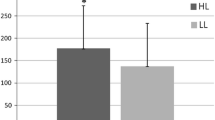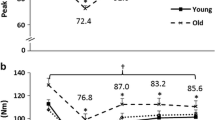Abstract
A training study was conducted to investigate effects of two modes of exercise on the strength and endurance characteristics of the lumbar musculature. Twenty symptom free male subjects were divided into either a preloaded isokinetic (49 Nm preload) or a pure isokinetic training group. Both groups trained for five sets of 10 repetitions at 30°/s for 3 sessions per week for 1 month. Maximum preloaded isokinetic endurance and strength increased 26% (P < .001) and 20% (P = .001) for the preloaded isokinetic group and −1% (NS) and 3% (NS) for the pure isokinetic group. Maximum isometric strength and isometric endurance increased 11% (P < .001) and 3% (NS) for the preloaded isokinetic group and 9% (NS) and 18% (P = .024) for the pure isokinetic group. Both training regimes did not significantly change EMG spectral parameters. The preloaded isokinetic group exhibited retention of strength and endurance gains for as long as a year. The results indicated that the preloaded isokinetic group yielded superior gains in strength and endurance as compared with the pure isokinetic group except for isometric endurance. The observed retention of gains in the preloaded group during follow-ups may help direct rehabilitation to include eccentrics with isokinetic training.
Similar content being viewed by others
References
Mayer TG, Gatchel RJ, Kishino N, Keeley J, Capra P, Mayer H, Barnett J, Mooney V. Objective assessment of spine function following industrial injury.Aprospective study with comparison group and one-year follow-up. Spine 1985; 10: 482–493.
Mayer TG, Gatchel RJ, Mayer H, Kishino ND, Keeley J, Mooney V. A prospective two-year study of functional restoration in industrial low back injury. An objective assessment procedure. JAMA 1987; 258: 1763–1767.
Hazard RG, Fenwick JW, Kalish SM, Redmond J, Reeves V, Reid S, Frymoyer JW. Functional restoration with behavioral support. A one year prospective study of patients with chronic low-back pain. Spine 1989; 14: 157–161.
Bendix AF, Bendix T, Labriola M, Bækgaard P. Functional restoration for chronic low back pain. Spine 1998; 23: 717–725.
Mayer T, McMahon MJ, Gatchel RJ, Sparks B, Wright A, Pegues P. Socioeconomic outcomes of combined spine surgery and functional restoration in workers' compensation spinal disorders with matched controls. Spine 1998; 23: 598–606.
Mitchell RI, Carmen GM. The functional restoration approach to the treatment of chronic pain in patients with soft tissue and back injuries. Spine 1994; 19: 633–642.
Risch SV, Norwell NK, Pollock ML, Risch ED, Langer H, Fulton M, Graves JE, Leggett SH. Lumbar strengthening in chronic low back pain patients. Physiologic and phsychological benefits. Spine 1993; 18: 232–238.
Mattila M, Hurme M, Alaranta H, Paljarvi L, Kalimo H, Falck B, Lehto M, Einola S, Jarvinen M. The multifidus muscle in patients with lumbar disc herniation. A histochemical and morphometric analysis of intraoperative biopsies. Spine 1986; 11: 732–737.
Mayer TG, Vanharanta H, Gatchel, RJ, Mooney V, Barnes D, Judge L, Smith S, Terry A. Comparison of CT scan muscle measurements and isokinetic truck strength in postoperative patients. Spine 1989; 14: 33–36.
Rissanen A, Kalimo H, Alaranta H. Effect of intensive training on the isokinetic strength and structure of lumbar muscles in patients with chronic low back pain. Spine 1995; 20: 333–340.
Hides JA, Richardson CA, Jull GA. Multifidus muscle recovery is not automatic after resolution of acute, first-episode low back pain. Spine 1996; 21: 2763–2769.
Biering-Sorensen F. Physical measurements as risk indicators for low-back trouble over a one-year period. Spine 1984; 9: 106–119.
Holmstrom E, Moritz U, Andersson M. Trunk muscle strength and back muscle endurance in construction workers with and without low back disorders. Scand J Rehab Med 1992; 24: 3–10.
Lee JH, Hoshino Y, Nakamura K, Kariya Y, Saita K, Ito K. Trunk muscle weakness as a risk factor for low back pain. Spine 1999; 24: 54–57.
Graves JE, Pollock ML, Foster D, Leggett S, Carpenter DM, Vuoso R, Jones A. Effect of training frequency and specificity on isometric lumbar extension strength. Spine 1990; 15: 504–509.
Mayer TG, Smith SS, Keeley J, Mooney V. Quantification of Lumbar Function. Part 2: Sagittal Plane Trunk Strength in Chronic Low-Back Pain Patients. Spine 1985; 10: 765–772.
Pollock ML, Leggett SH, Graves JE, Jones A, Fulton M, Cirulli J. Effect of resistance training on lumbar extension strength. Am J Sports Med 1989; 17: 624–628.
Fleck SJ, Kraemer WJ. Designing resistance training programs. Champaign, IL: Human Kinetics Publishing, 1987.
Ciriello VM, Holden WL, Evans WJ. The effects of two isokinetic training regimes on muscle strength and fiber composition. In: Knuttgen HG, Vogel JS, Poortmans J, eds. Biochemistry of exercise. International series on sport sciences, vol. 13, Champaign, IL: Human Kinetics Publishers, 1982, pp. 787–793.
Ciriello VM.Alongitudinal study of the effects of two training regimes on muscle strength and hypertrophy of fast-twitch and slow-twitch fibers. Doctoral Dissertation, Boston University, Boston, MA, 1982, (University Microfilms).
Mayhew TP, Rothstein JM, Finucane SD, Lamb RL. Muscular adaptation to concentric and eccentric exercise at equal power levels. Med Sci Sports Exerc 1995; 27: 868–873.
Ploutz-Snyder LL, Tesch PA, Dudley GA. Increased vulnerability to eccentric exercise-induced dysfunction and muscle injury after concentric training. Arch Phys Med Rehabil 1998; 29: 58–66.
Kovaleski JE, Heitman RH, Trundle TL, Gilley WF. Isotonic preload versus isokinetic knee extension resistance training. Med Sci Sports Exerc 1995; 27: 895–899.
Roy SH, DeLuca CJ, Casavant DA. Lumbar muscle fatigue and chronic low Back pain. Spine 1989; 14: 992–1001.
DeLuca CJ. Myoelectric manifestations of localized fatigue. CRC Crit Rev Biomed Eng 1985; 11: 251–279.
DeLuca CJ. Use of the surface EMG signal for performance evaluation of back muscles. Muscle Nerve 1993; 16: 210–216.
Mannion AF, Dolan P. Electromyographic median frequency changes during isometric contraction of the back extensors to fatigue. Spine 1994; 19: 1223–1229.
Mannion AF, Dumas GA, Stevenson JM, Cooper RG. The influence of muscle fiber size and type distribution on electromyographic measures of back muscle fatigability. Spine 1998; 23: 576–584.
Ciriello VM, Snook SH. The effect of back belts on lumbar muscle fatigue. Spine 1995; 20: 1271–1278.
Peach JP, McGill SM. Classification of low back pain with the use of spectral electromyogram parameters. Spine 1998; 23: 1117–1123.
Roy SH. The role of muscle fatigue in low back pain. In: D'Orazio BP, ed. Back pain rehabilitation. Boston: Andover Medical Publishers, 1993, pp. 149–179.
Roy SH, DeLuca CJ, Emley M, Bluijs JC. Spectral electromyographic assessment of back muscles in patients with low back pain undergoing rehabilitation. Spine 1995; 20: 38–48.
Moffroid MT, Haugh LD, Haig AJ, Henry SM, Pope MH. Endurance training of trunk extensor muscles. Phys Ther 1993; 73: 3–10.
Biedermann HJ, Shanks GL, Forrest WJ, Inglis J. Power spectrum analysis of electromyographic activity. Discriminators in the differential assessment of patients with chronic low-back pain. Spine 1991; 16: 1179–1184.
Klein AB, Snyder-Mackler L, Roy SH, DeLuca CJ. Comparison of spinal mobility and isometric trunk extensor forces with electromyographic spectral analysis in identifying low back pain. Phys Ther 1991; 71: 445–454.
Roy SH, DeLuca CJ, Snyder-Mackler L, Emley MS, Crenshaw RL, Lyons SP. Fatigue, recovery, and low back pain in varsity rowers. Med Sci Sports Exerc 1990; 22: 463–469.
Tucci JT, Carpenter DM, Pollock ML, Graves JE, Leggett SH. Effect of reduced frequency of training and detraining on lumbar extension strength. Spine 1992; 17: 1497–1501.
Mooney V, Kron M, Rummerfield P, Holmes B. The effect of workplace based strengthening on low back injury rates: A case study in the strip mining industry. J Occ Rehab 1995; 5: 157–167.
Author information
Authors and Affiliations
Rights and permissions
About this article
Cite this article
Ciriello, V.M., McGorry, R.W. Effects of Preloaded Isokinetic versus Pure Isokinetic Training on Dynamic and Static Lumbar Muscle Strength and Endurance. J Occup Rehabil 10, 257–269 (2000). https://doi.org/10.1023/A:1009432332196
Issue Date:
DOI: https://doi.org/10.1023/A:1009432332196




